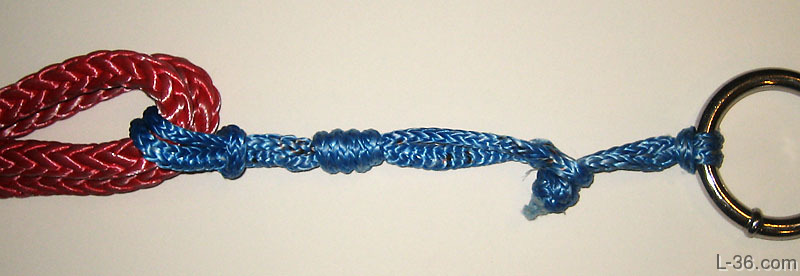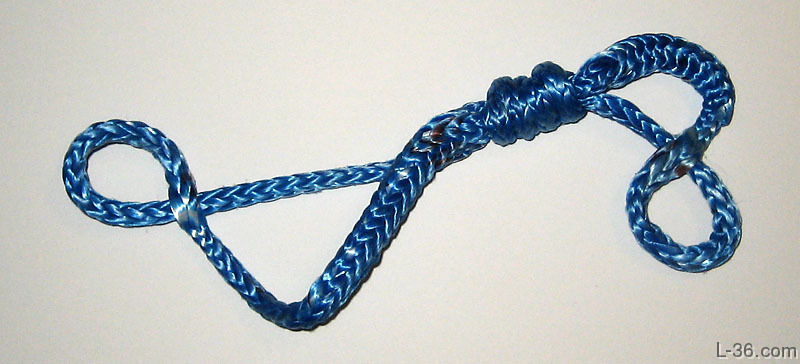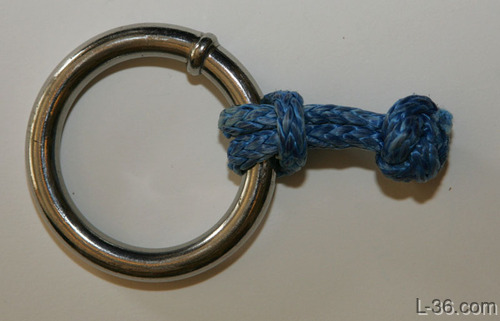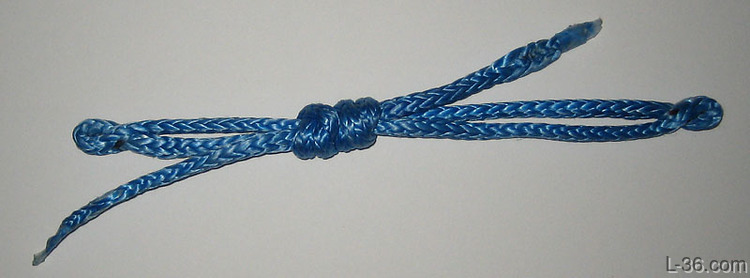Double Soft Shackle
Soft Shackle Variation #6
This double ended soft shackle is the 3rd generation of a design that can attach to a pair of eye spliced jib sheets to the clew of a sail very quickly. The shackle is secure around the jib sheet prior to being "clipped" to the clew. This version is very easy to make and more secure than previous versions. There are links to the previous versions at the bottom of this page
The Shackle



Overview
The shackle has two sections. The short section will attach to the Stopper Knot. That needs to be long enough to allow the shackle to open enough to pass the stopper knot thought the loop. I used 3 1/4 inches. The center knot is a double fisherman's knot. It is tied using the tails that come from the eyes in the shackle ends. The long section needs to be long enough to go around your target, in my case a pair of eye spliced jib sheets. In addition, it must have enough extra length to allow the eye to open so that the center knot can pass thought it while the shackle is around the eyes of the jib sheet. I used 5 1/2 inches. Note: These dimensions are for 3/16 Amsteel.Testing
I tested this shackle with 7/64 Amsteel using a 1/8 inch stopper knot. The shackle broke at the eye and the knot did not slip. The next test I did used a larger stopper knot. That decreased the radius and made the eye stronger. The shackle broke on the other end where the eye loops back on the shackle around where you would put the jib sheets. The shackle broke at much less than line strength. I have developed a new version that is quite a bit stronger. I would recommend usint it instead. Previous testing indicated that if the same size line is used for the stopper knot, that would be the weak link. Using the next size up line for the stopper loop makes eliminates that failure mode.

Stopper Loop
Note: For maximum strength of the double soft shackle, use the next size up line for the stopper knot.Using the calculator from the Soft Shackle Howto, measure off a piece twice the length of the first mark. Double the line over, tape it at the fold, and tie a diamond knot using the two ends. Lock it by placing the ends in a vice and pulling on the loop with a lever of some kind. I use a hammer with the had as the fulcrum and the loop on the handle near the head.

How to Make The Double Shackle
These instructions are for 3/16 Amsteel.Method 1
- Cut a piece of Amsteel to 34.5 inches.
- Mark 12 1/8 from one end.
- Insert that end through that mark making the eye for the shorter end
- Mark 14 3/8 from the other end
- Insert that end through the mark making the eye for the longer end
- Arrange the eye openings so that they are too small. Ultimately the short one will be the size of the base of your stopper knot and the long one can pass two sections of the line you are using for the shackle. But we will make them larger later so they need to be small now.
- Lay out the lines all parallel to each other.
- Mark 3 1/4 inches from the tip of the eye of the short section.

- Using the longer tail, tie the first part of a double fisherman's knot so that the edge of the knot with the tail sticking out is at your mark. I seem to have tied single fisherman's knots in the pictures. Oops. You should do as I say, not as I do :-)
- Tighten that knot, and reset everything to make sure that the knot is aligned with the edge of the mark and that the eye openings are still the correct size.

- Move the knot about 1/4 inch toward the eye by slipping it on the lines.
- Tie the other half of the double fisherman's knot next to the first half.
- Tighten both knots and check your eye openings. If they are correct, lock them (see below).

- At this point, the eyes should be a bit small ideally with the short section a bit larger than the eye on the long section. The double fisherman's knot should start 3 1/4 inches from the tip of the eye.
- Using a fid that is the diameter of the line (I use a #7 knitting needle) insert it in the section of the eye that is passed through right at the base. Inserting this in the line will shorten it. Because the other half of the line stays long, the net effect is that the eye will open. You need to milk the two lines smooth to open the eye. Press it in long enough until the eye is the desired finished size.
- Mark the very tip of the needle on the line it is in. Also mark the tail at that same point.

- Using a fid, insert the tail in where you put the knitting needle, exiting somewhat past your mark.
- Cut the tail at an angle approximating the taper of the knitting needle and to the marked length.
- Repeat for the other end.
- Lock stitch the buried sections.
- Add some lanyards to help open the eyes if desired.

Method 2
This is the same as method 1 except make the eye openings the correct size initially but stop at number 13. Leave a bit of tails to allow for tightening.Locking the knots
The knots need to be very tight. Once you get the basic layout with the knots in place and the eye openings correct but on the tight side you need to pull on the tails to tighten the knots. The problem is that if you were to pull on both tails it would just pull the knots apart as they are set up to resist the opposite force. The best way I have found is to clamp a thick washer with a sufficient sized hole and pass all three strands though the hold. Then grab the tail with vice grips and use the leverage of the pliers against the vice to put as large a force as you can on the knot. Do it in stages and make sure the shackle is still aligned with proper but small eyes. Once the knots are rock hard, set up your winch to pull on the shackle as you would in use. Crank as hard as you can. That will do the final set and open up the eyes just a bit making them the desired size. If you want to do method 1, make the eyes a bit larger to begin with but I like to try for method 2 and fall back on method 1 if the eyes end up the wrong size. Note however that the eyes can in reality be big enough to pass through the stopper know and the shackle will still work as the forces will close the knot unless it gets large enough to shake out. Thus anything less than that the size of the diamond knot should be fine. In summary, the eye should to be larger than the base of the stopper loop and less than the stopper knot itself.NOTES
- This shackle cannot be used as a single shackle leaving one eye unloaded. It will slip
- The trick in building these is locking the knot. If the knots are not properly locked, the eyes will grow under load until they lock themselves.
Version 1
Version 2
NOTICE: Some pages have affiliate links to Amazon. As an Amazon Associate, I earn from qualifying purchases. Please read website Cookie, Privacy, and Disclamers by clicking HERE. To contact me click HERE. For my YouTube page click HERE